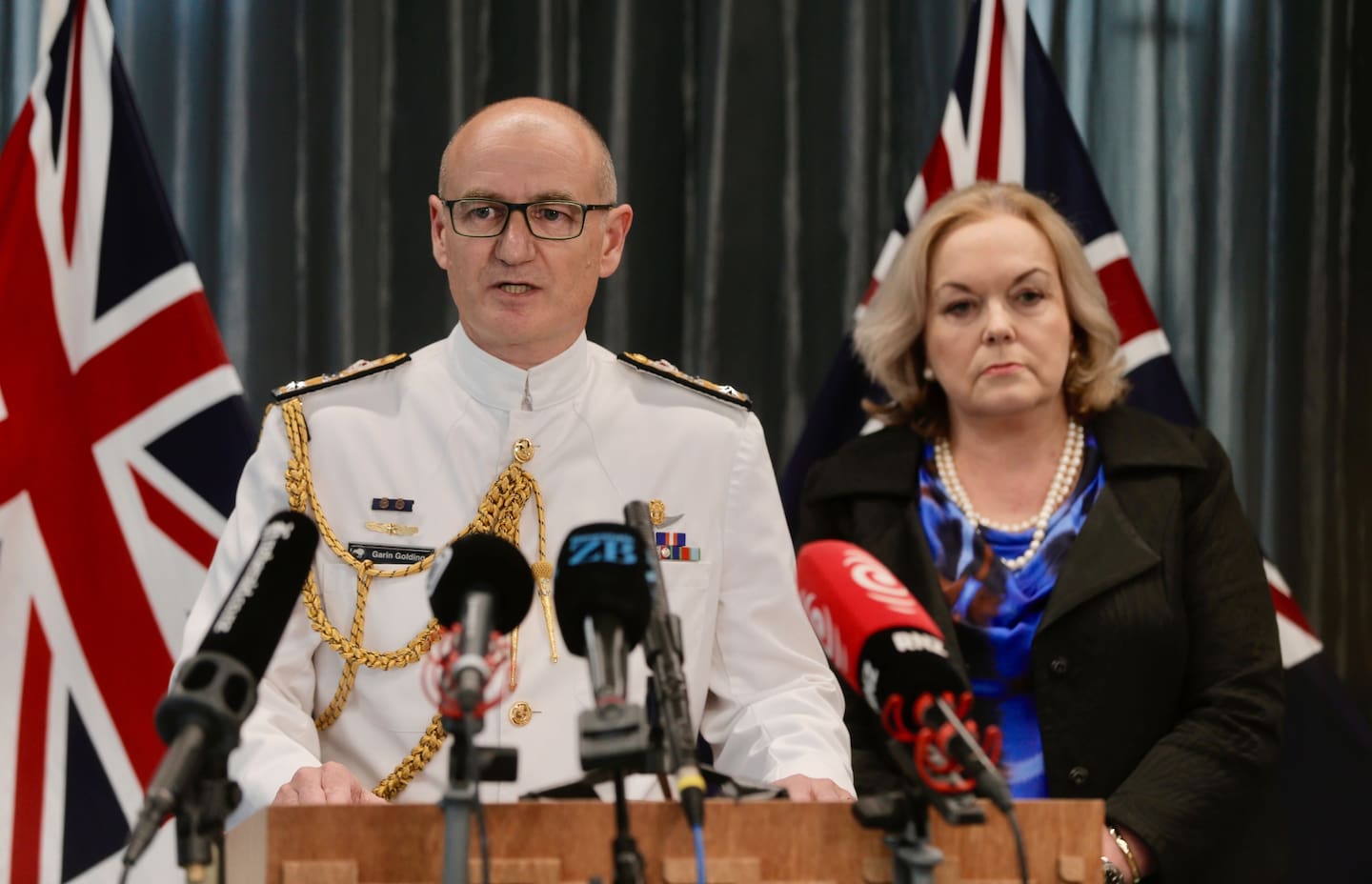- The HMNZS Manawanui sank off Samoa on October 6 after striking a reef and catching fire.
- The interim report earlier identified human error as the cause, with the ship’s autopilot not being disengaged.
- Minister Collins and Rear-Admiral Golding expressed disappointment and outlined plans for salvage and risk assessment.
Human error and the failure to disengage an autopilot control has been confirmed as the root cause of a New Zealand navy ship running aground and sinking in the Pacific, a report has concluded.
New Zealand’s navy and Defence Minister fronted a media conference today to deliver the final findings into how one of the country’s warships sunk off the coast of Samoa last year.
Addressing the nation, Defence Minister Judith Collins and Chief of Navy Rear-Admiral Garin Golding unveiled the Court of Inquiry’s final report into the ship’s loss.
The $100 million HMNZS Manawanui motored into a reef off the coast of Samoa at a speed of 11 knots last October, travelling 365 metres after the initial impact and grounding multiple times along the way.
It took 10 minutes for the crew to regain full control of the ship’s propulsion system, when crew members disengaged the autopilot, a Court of Inquiry final report delivered today found.
The ship sunk as a result of hull damage with crew members able to evacuate.
“The direct cause of the grounding has been determined as a series of human errors in that the ship was put on a heading towards land and the autopilot mode was not disengaged,” the report stated.
“Remaining in autopilot resulted in the ship maintaining a course of 340 degrees toward land, until grounding and eventually stranding.”
An interim version of the report delivered in November last year had earlier found human error resulted in HMNZS Manawanui’s sinking.
It comes as navy teams continue salvage efforts at the wreck when they last week cut into secure compartments to retrieve weapons and ammunition.
HMNZS Manawanui, a specialist survey and dive support vessel, first ran into trouble on Saturday, October 5, 2024 when it struck a reef in Samoan waters.
It began to list and Commander Yvonne Gray gave the order to abandon ship.
A fire broke out in the engine room and the $100 million vessel sank that Sunday morning, off the south coast of the Samoan island of Upolu.
 HMNZS Manawanui foundered off the coast of Upolu, Samoa, on October 5. Photo / Supplied
HMNZS Manawanui foundered off the coast of Upolu, Samoa, on October 5. Photo / Supplied
Interim report blamed ‘human error’ for sinking
Human error was the root cause of the vessel’s sinking, the interim report concluded.
Golding said the direct cause of the grounding was because of a series of human errors, resulting in the ship’s autopilot “not being disengaged when it should have been”.
 Chief of Navy Rear-Admiral Garin Golding and Defence Minister Judith Collins also addressed the media about the inquiry last year. Photo / Alex Burton
Chief of Navy Rear-Admiral Garin Golding and Defence Minister Judith Collins also addressed the media about the inquiry last year. Photo / Alex Burton
He earlier said the crew did not realise Manawanui remained in autopilot and, mistakenly believed its failure to respond to direction changes was the result of a thruster control failure.
“Having mistakenly assessed a thruster control failure, standard procedures should have prompted the ship’s crew to check that the ship was under manual control rather than in autopilot,” Golding said late last year when the interim report was released.
“This check did not occur. Remaining in autopilot resulted in the ship maintaining a course toward land, until grounding and eventually stranding.”
Golding previously said the incident had “obviously” had an impact on New Zealand’s reputation, and the Navy needed to “own” their mistake.
He said the investigation panel was looking at three people for responsibility for the incident: the pilot, the officer overseeing the pilot, and the officer overseeing the ship.
Timeline of HMNZS Manawanui’s sinking:
- On Saturday, October 5, 2024, HMNZS Manawanui was conducting survey operations on the southern side of Apia, Samoa, in a strong breeze of up to 25 knots and moderate swell.
- The survey was conducted in a box-shaped area, running east to west in survey lanes that start on the outside, working inwards.
- At about 6.15pm, the ship’s crew attempted a routine turn to starboard, initially to a course of 340 degrees, within the survey area, as part of a turn. The crew attempted to turn off the 340-degree course to starboard towards an easterly course but the ship did not respond as intended.
- Shortly after, Manawanui left the approved survey area and, in an effort to stop the ship, the crew conducted further actions they believed should have resulted in the ship essentially braking.
- Manawanui did not slow or stop, and instead it started to accelerate towards the reef, grounding for the first time at or about 6.17pm at a speed of more than 10 knots.
- The ship then travelled around 635 metres before becoming stranded, grounding multiple times along the way.
- Full control of Manawanui’s propulsion system was not regained until 10 minutes later, at 6.27pm, when the ship’s autopilot was disengaged. The inability to turn the ship to an easterly direction from the 340-degree course and stop it is attributed to it being in autopilot mode.
- Unsuccessful attempts were then made to manoeuvre the ship off the reef.
- Manawanui was brought to emergency stations after the grounding, and searches were conducted to check for damage.
- No damage or flooding was detected inside the ship. However, stability assessments made after the grounding indicated Manawanui was no longer stable.
- At approximately 6.46pm, about 30 minutes after the initial grounding, the decision was made to abandon ship.
- The timeliness of the decision to abandon ship and to keep Manawanui’s generators running contributed to the successful abandonment process and likely prevented serious injuries or death.
- The ship suffered a series of catastrophic fires after being abandoned, before capsizing and sinking on the morning of Sunday, October 6.
Take your Radio, Podcasts and Music with you









